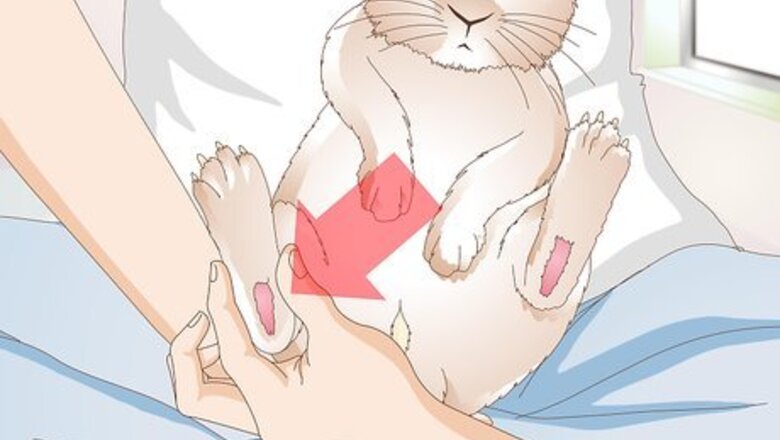
views
Treating Sore Hocks
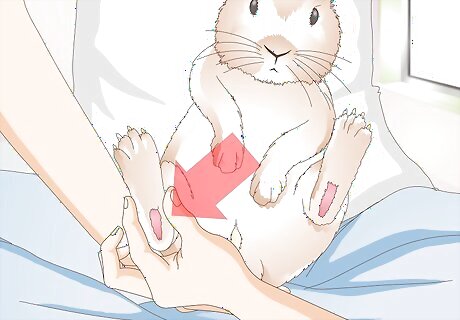
Identify sore hocks. Pododermatitis, also called sore hocks, is a common ailment among rabbits. This painful condition can be easily prevented with proper exercise and comfortable housing. Once the condition has set in, though, you'll need to take quick action to treat the injury. Leaving it untreated will lead to infections and further pain. Early signs of sore hocks include loss of hair on the bottom of the affected paw(s). As the condition worsens, the exposed skin will turn red and become inflamed. Ulcers and scabs may develop if left untreated, followed by a skin abscess. In severe cases, this may lead to inflammation of the tendons and deep tissues in your rabbit's paw. If the condition gets to the point of your rabbit displaying an abnormal stance and walking pattern, it may have inflicted severe and permanent damage. Do not attempt to wrap up sore hocks if there are any open sores, as this may make the injury worse. If caught early, you should be able to treat sore hocks at home. However, if you notice any advanced signs of sore hocks, you should take your rabbit to see your veterinarian as soon as possible.
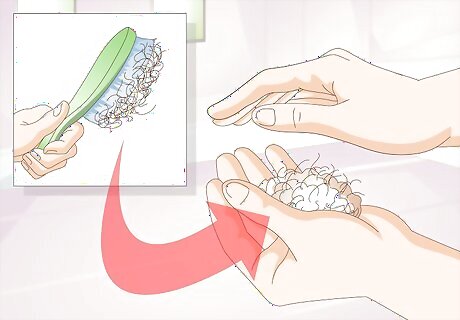
Make a rabbit fur compress. In order to treat sore hocks, you'll need to replace the missing fur with some of the rabbit's own fur (or, ideally, from another rabbit). This will help pad the injury until the skin heals and the fur begins to regrow. To make a fur compress, you will need to: Brush some spare fur off of your rabbit. Ideally, you should brush it off of a healthy rabbit to avoid further trauma to the injured animal, but if you only have one rabbit it will do. Roll the fur between the palms of your hands until you form a mat of fur approximately two inches long, two inches wide, and one inch deep. The mat of fur you form should be soft and spongy, but with some firmness. Do not attempt to use cotton, gauze, or any other type of man-made padding. These materials can form hard mats while applied to the paw, which may further irritate the injury. Keep in mind that although rabbit fur provides excellent padding, it is not sterile. Therefore, there is a risk of introducing an infection to an open sore. To reduce this risk, avoid using rabbit fur on an open wound. The fur may stick to blood or other secretions and this can make it hard to remove the fur. That is why this method is best for skin that is merely red and inflamed, rather than broken.

Cut a self-adhesive bandage. Once you've made a fur mat, you'll need to secure it in place. The easiest way to do this is by cutting a self-adhesive bandage to the correct size and shape so that you can then apply it to the affected paw. Something specifically made for pets, such as VetWrap, is ideal. In a pinch, though, self-adhesive bandages for humans can work. Cut a long strip of self-adhesive bandage. It should be approximately nine inches long and two inches wide. Next, cut straight lines down the strip lengthwise from both ends, leaving approximately one inch of strip uncut in the middle. It should look somewhat like an H or an X.
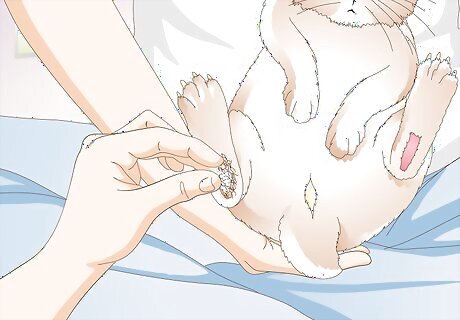
Place the fur mat on the injured paw. Have someone carefully hold your rabbit on its back, with its underside facing up. Then gently press the pad you made out of rabbit fur against the bare spot on the rabbit's sole. Remember that you should only use fur, not cotton or any other man-made material.Try to gently tuck some of the rabbit's remaining paw fur over the bare spot to secure the fur mat in place.
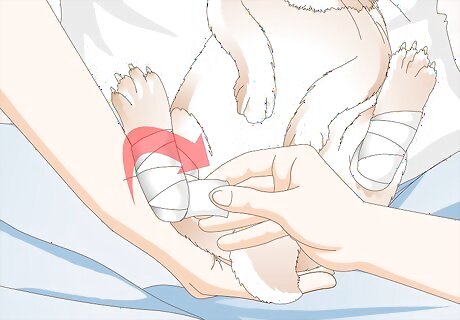
Wrap up the injured paw. Keep your materials close at hand. You will need the fur mat that you made and the pre-cut self-adhesive bandage to secure it in place. Have a friend continue to hold the rabbit securely so that you can focus on treating its paw. Position the uncut middle section of your self-adhesive bandage over the rabbit's heel and ankle. Make sure the fur mat is still in place before wrapping. Wrap the four strips of the self-adhesive bandage above and below the rabbit's ankle to secure the fur mat in place. Do not wrap too tightly, as this can worsen the condition. The wrap should be loose enough that you could easily slide a popsicle stick between the rabbit's leg and the bandage, but tight enough to stay on and in place. (Do not actually stick anything inside the bandage; just eyeball it to make sure it's not too tight.)

Cut a flex point out of the wrap carefully. Once the wrap is on, you'll need to cut out a small flex point. This is because rabbits naturally bend and flex their ankles in order to sit, stand, and move. Without a flex point, your rabbit could develop new sores on the front of its ankle underneath the wrap. Pull up on the bandaging in the front (above the rabbit's ankle). Pinch and hold the bandage away from the skin so you don't cut through to the leg. Use blunt-tipped scissors to avoid stabbing or cutting the rabbit's paw. Your rabbit may be jumpy at this point, so have your friend continue to hold the rabbit tightly, and exercise great care as you cut out the flex point. The flex point should ideally be cut in the shape of a diamond or a circle to best facilitate movement.

Check the front of the foot every few hours. Once you've finished wrapping up the paw, you'll want to check on the rest of the foot every few hours. Look for swelling and/or redness in the toes and front part of the foot (which should remain unwrapped). If you notice any redness or swelling, it means you've wrapped the foot too tightly. However, if the bandage has spun around or gotten bunched up around the ankle or knee, it means you've wrapped it too loosely. If there are any problems with the wrap (too loose or too tight), have someone hold your rabbit with its belly up again. Unwrap the bandaging and carefully rewrap it accordingly. Even if bandaged correctly, you'll need to rewrap the injury with fresh bandages and new fur mats every day. If the bandaging gets wet or soiled in any way, unwrap it and change the dressings immediately to prevent infection. Follow up with your veterinarian for a full evaluation to ensure that there's nothing else wrong and to see if antibiotics are needed.
Rehabilitating a Sprained Leg
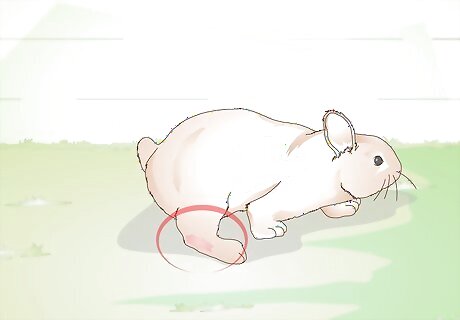
Recognize the signs of a sprained leg. It may be difficult to differentiate a sprained leg from a fractured or broken leg. If you are certain that the leg is just sprained, you should be able to care for it at home on your own. If you're unsure about what's wrong with your rabbit, or if there's a chance the rabbit's leg or back might be broken, you'll need to take it to a vet for a firm diagnosis and treatment plan. Look for the following signs as common indicators of a sprained leg: wobbliness or weakness in one leg a hunched walk that favors three out of four legs ability to bear some weight on the leg, but with a limp
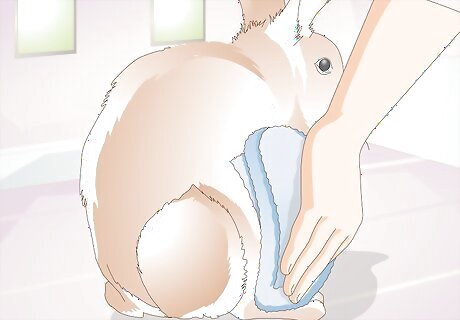
Apply cold therapy to the affected leg. Cold therapy is the best treatment for any sprain. The ice pack will reduce the flow of blood to the site of the injury, which can help reduce swelling and inflammation. It can also reduce some of the pain at the site of the injury. Wrap a cold ice pack in a clean dish towel or washcloth. Apply the wrapped ice pack directly to the affected leg. You may need someone to help hold your rabbit so that you can continue to apply the ice pack. Try to leave it on for about 10 minutes, if your rabbit will let you. If not, try to keep the ice pack on for as long as possible. Call your veterinarian to schedule an appointment so that he or she can give your rabbit a full physical examination.
Wrapping a Broken Leg
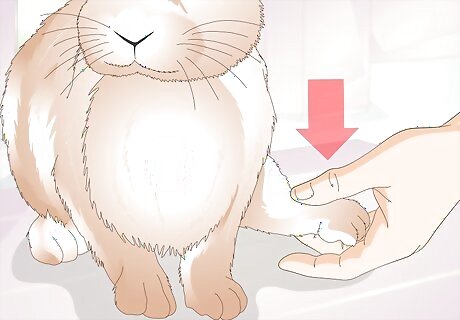
Identify which leg is injured. If your rabbit is having difficulty walking or is completely incapable of walking, it is probably suffering from a leg injury. If your rabbit is dangling or dragging one leg, it is most likely broken. If the rabbit limps but seems to be capable of carrying some weight on the injured leg, it may be sprained, dislocated, or fractured. Your vet will need to evaluate the injury to determine how serious it is and how to remedy it. Pick your bunny up while supporting its rear with your other hand. While still holding your rabbit (do not let go or drop the rabbit at any time), gently try to get the rabbit to stand with good footing. Whichever leg the rabbit tries to avoid standing on is most likely the injured leg. If your rabbit drags both hind legs, it may have suffered a spinal injury and will need immediate veterinary assistance. Your vet will need to administer steroids and other medications, and may put a body cast on as well.
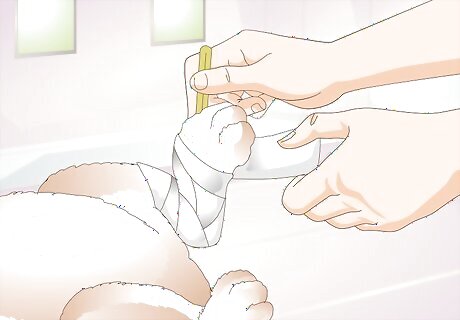
Splint the injured leg. If your rabbit will let you, the best way to treat a leg before taking your rabbit to the vet is to splint the leg with something firm. This will help reduce painful movements of the limb until your vet can examine the injury and treat it accordingly. Wrap clean gauze around the leg above and below the site where you think the leg is broken. Gently place a pencil, popsicle stick, or similarly firm object lengthwise against the outside of the leg, covering the suspected site of the break and extending above and below it. Use tape or a self-adhesive bandage to wrap the leg, including the splint, up and down the leg. Make sure you don't wrap too tightly, or you may risk cutting off circulation to the rabbit's paw. If your rabbit's paw turns red or swollen, you've wrapped it too tightly and will need to rewrap it accordingly.
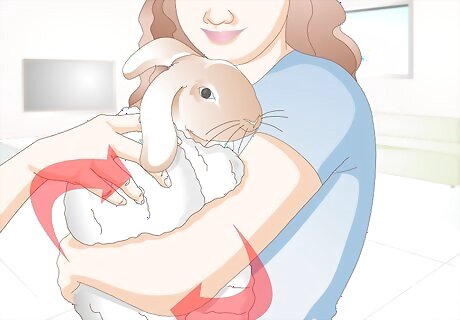
Wrap your rabbit in a clean towel. If your rabbit won't let you splint the injury, or if your rabbit is being difficult about handling after splinting the injury, you may need to wrap it in a towel. This will allow you to easily handle and carry your rabbit without further injuring the broken leg. However, you'll need to take great caution while wrapping the rabbit in a towel, as it may be frightened or in pain at this point. Use a clean, dry towel. Wrap the towel around your rabbit snugly, leaving the head uncovered. Make sure the rabbit's back and hind end are in a natural position, and that the spine is not bent or twisted.
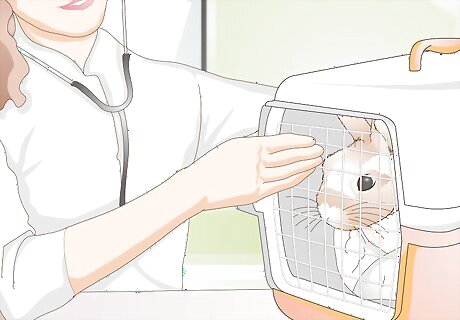
See a vet right away. You'll need to put your rabbit inside a carrier, even if you had to wrap the rabbit in a towel first. Carefully place the rabbit inside the carrier (towel and all) and take the rabbit to your veterinarian right away. It's important that you don't delay, as an untreated broken limb could be a very serious injury.
Identifying and Preventing Future Injuries
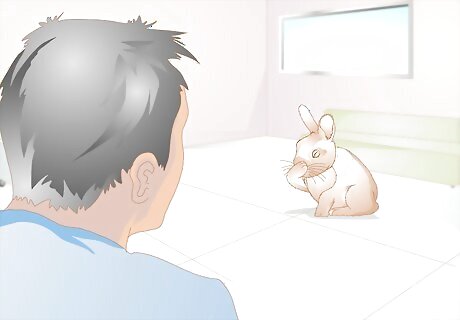
Recognize the signs of an injured rabbit. Before you can treat any injury, you'll need to be able to identify the signs of an injured rabbit. Since rabbits cannot vocalize pain like some other animals can, you'll need to watch your rabbit's behavior and carefully examine any suspected injuries. An injured rabbit may display strange behavior, or it may act perfectly normal. Look for prolonged lack of movement, extended periods of time spent lying on its side, tilting of the head, falling over, difficulty moving, and an inability to move in a straight line. Contact your vet any time you're unsure about your rabbit's behavior.
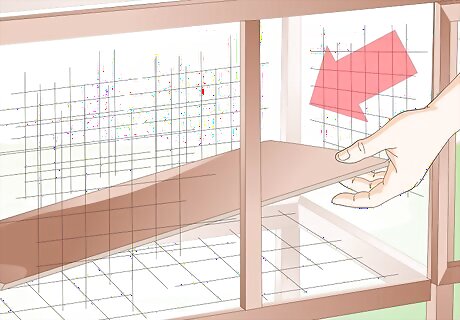
Prevent sore hocks. Sore hocks is an easily-preventable ailment that usually stems from an improper diet and exercise regimen or from a painful or unsanitary living area. Take precautions to ensure that your rabbit is eating healthy (and not overeating), getting enough exercise outside of the cage every day, and has a comfortable space inside its cage. If you use a metal wire cage, make sure your rabbit has some type of surface inside the cage (like a flat board, for example) to sit, stand, and lie on so that the wires do not dig into its paws all day. You should also provide two to three inches of soft bedding material for your rabbit to sit on. This will help to take some of the pressure off of your rabbit's hocks. If you use a solid, flat-bottomed cage, make sure you keep the floor clean. Wipe away urine and other spills on a daily basis, as exposure to urine will irritate the tissue and burn the skin. Keep your rabbit on a healthy, regulated diet and give it plenty of exercise time outside the cage to prevent obesity. Being overweight is a common cause of sore hocks in rabbits, and it can easily be prevented.

Use caution when lifting and handling rabbits, to prevent injury. One of the most common causes of broken, fractured, and sprained limbs and backs in rabbits is improper handling. Any time you lift your rabbit, you need to be careful and anticipate that it might flail or try to jump out of your arms, which could cause serious injury. If your rabbit struggles when you restrain it or try to lift it, don't try to force your grip. Let go of your rabbit and focus on calming it down before you try to pick it up or handle it again. Forcing your rabbit to let you handle it will only cause the rabbit to panic and flail more, which could result in broken limbs (if it falls) or even a broken back. Get close to the ground before attempting to lift a rabbit. Hold it gently but firmly with one hand supporting the rabbit's back and hind end at all times.

















Comments
0 comment